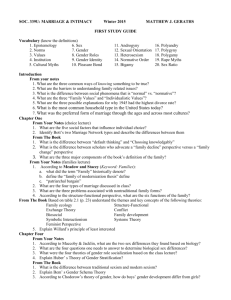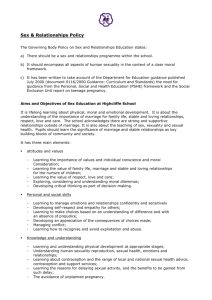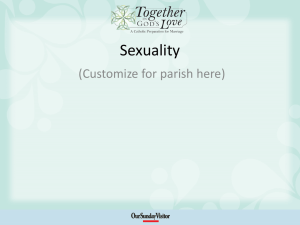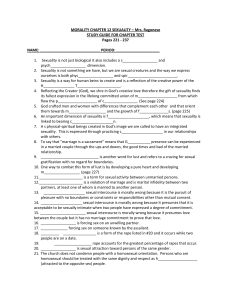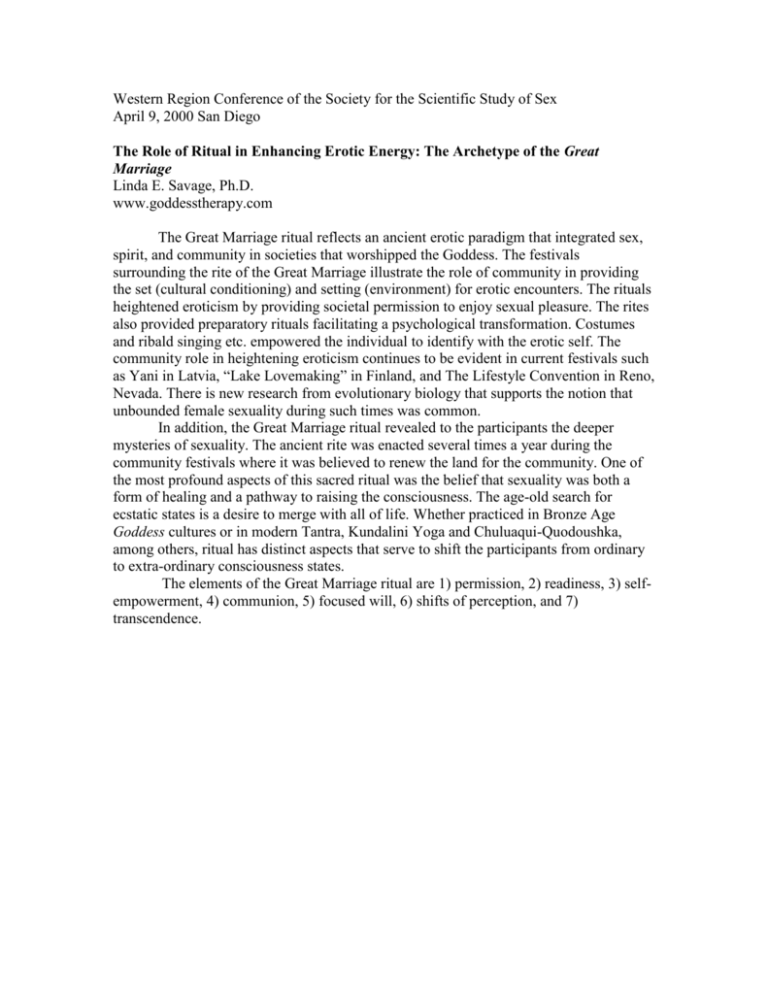
Western Region Conference of the Society for the Scientific Study of Sex
April 9, 2000 San Diego
The Role of Ritual in Enhancing Erotic Energy: The Archetype of the Great
Marriage
Linda E. Savage, Ph.D.
www.goddesstherapy.com
The Great Marriage ritual reflects an ancient erotic paradigm that integrated sex,
spirit, and community in societies that worshipped the Goddess. The festivals
surrounding the rite of the Great Marriage illustrate the role of community in providing
the set (cultural conditioning) and setting (environment) for erotic encounters. The rituals
heightened eroticism by providing societal permission to enjoy sexual pleasure. The rites
also provided preparatory rituals facilitating a psychological transformation. Costumes
and ribald singing etc. empowered the individual to identify with the erotic self. The
community role in heightening eroticism continues to be evident in current festivals such
as Yani in Latvia, “Lake Lovemaking” in Finland, and The Lifestyle Convention in Reno,
Nevada. There is new research from evolutionary biology that supports the notion that
unbounded female sexuality during such times was common.
In addition, the Great Marriage ritual revealed to the participants the deeper
mysteries of sexuality. The ancient rite was enacted several times a year during the
community festivals where it was believed to renew the land for the community. One of
the most profound aspects of this sacred ritual was the belief that sexuality was both a
form of healing and a pathway to raising the consciousness. The age-old search for
ecstatic states is a desire to merge with all of life. Whether practiced in Bronze Age
Goddess cultures or in modern Tantra, Kundalini Yoga and Chuluaqui-Quodoushka,
among others, ritual has distinct aspects that serve to shift the participants from ordinary
to extra-ordinary consciousness states.
The elements of the Great Marriage ritual are 1) permission, 2) readiness, 3) selfempowerment, 4) communion, 5) focused will, 6) shifts of perception, and 7)
transcendence.
1
The Role of Ritual in Enhancing
Sexual Eroticism
Last year at the Regional Conference in San Francisco, I introduced the ritual of
the Great Marriage as an archetype for female sexuality as it was viewed by the cultures
that honored the divine feminine. Collectively these are called the Goddess cultures. For
those of you that are new to the Goddess information, there are cultures that existed for
more than 30,000 years and until around 5 to 8,000 years ago that were women-centered
as well as women honoring.
Women’s sexual desire in these ancient matrilineal societies was considered an
active, powerful erotic drive. Their view of women’s sexuality was far more life
affirming. The wisdom of ancient cultures is that sexual desire is a sacred gift of the
Great Mother. In these cultures women were raised to feel plenty of permission to
explore sexual pleasure, without judgement, and in a worldview that integrated sexuality
with spirituality.
This presentation will be in two parts: First I’ll be talking about the festivals
surrounding Sacred Marriage rite and their role in enhancing eroticism in the community.
The second part will discuss the mystery rites themselves, which were performed in a
more private setting. These rites fulfilled sacred purposes as a central part of the ritual.
The Sacred Marriage depicts the spiritual meaning of sex and I will present some ideas
about the relatively new field of study called Spiritual Sex.
These societies that worshipped the Great Mother valued rather than feared sexual
desire and in fact, their festivals celebrated sexual eroticism. Sexual pleasure rather than
fertility was foremost. Sexual union was taken very seriously as a sacred and magical act.
The Great Marriage ritual was seen as a necessary prerequisite to communal abundance.
The Celtic society was one of the last Goddess cultures to continue performing
the Great Marriage. We know that the Beltane festival (from which we derive our May
Day celebration) was practiced into the Christian era, until it was ruthlessly stamped out.
Archeologists who wrote about such practices were generally steeped in Victorian
mores. They misnamed the rituals “fertility rites” because of patriarchy’s prevailing
emphasis on procreation as the only proper purpose of sex.
These rites should really be called celebrations of eroticism. The festivities
surrounding the rituals in the pagan world included ribald singing, wild dancing, erotic
costumes, and drinking libations (in other words, a general good time). They often
included some kind of freeing up of marital bonds to allow for sex with partners outside
committed pairs. According to Terry Gould, the purpose of the spouse sharing was to:
1. Extend kinship ties
2. Satisfy the innate desire in both men and women for variety in a “blowing off steam”
sexuality
The community rituals clearly heightened eroticism for its participants. In
2
addition, the open expression of women’s sexuality functioned as a balancing force to
male competitive aggression.
Such open female eroticism in later times was considered to be quite dangerous to
society and punishable by law. For example, in medieval times wives were dragged by
their husbands to priests and flogged for being “wanton,” which meant wanting more sex
than their husbands.
During these festivals, the pleasure/erotic aspect of sex was elevated to the
priority and the procreative/fertility aspects took a back seat.
In Northern Europe, they drank mead laced with mistletoe (which is still a symbol
of license to kiss) in order to minimize the possibility of conception.
Many of the activities in these festivals, such as the ribald joking and erotic
exhibitionism demonstrated the unbounded expression of women’s sexual energy.
Many such rituals were still celebrated just 500 years before the common era. Egypt
celebrating the Cat Goddess Bast :
“With its flutes and castanets, its buffoonery and ribaldry its wine drinking
and jokes bandied between pilgrims and frank display of genitalia exhibited by the
women, this great and raucous celebration on the Nile typifies the kind of women’s
rituals performed at a number of sites in the ancient world.” From the
Metamorphosis of Baubo
I’d like to give you a bit of background on the ritual of the Sacred Marriage
The earliest known form of religious expression was the worship of the Goddess.
In the beginning, as author Merlin Stone says, God was a woman. Earth Mother, Great
Mother of All, or Great Goddess were names given to venerate the feminine as the origin
of material form. She was the primal creator of all life. Evidence of the Neolithic rock
paintings, sculptures and figurines illustrate the veneration of Divine Woman and Her
Yoni.
To the ancients, the female genitals had great magical power as the gate to all life.
Death was seen as a return to the Mother’s womb. Thus, sacred caves represented the
womb and burial mounds were sculpted with Yoni-shaped entrances. The worship of the
Yoni has continued in secret tantric sects in modern day India. In Europe and the U.S.
there are groups that also practice the worship of the Amrita Nectar.
The origins of the Great Marriage ritual itself date back to at least Neolithic times.
There is evidence of festivals where a wedding ritual was performed that enacted the
mating of a male consort with the Great Goddess. It is entirely possible that the people
believed that this sacred marriage strengthened their bond to the Goddess and ensured her
abundance.
THE RITUAL OF THE GREAT MARRIAGE reflects the reverence attributed to
sexual union and the wide appreciation of its crucial role in continuing a prosperous
society. It was enacted several times a year and was believed to renew the land.
The High Priestess of early Bronze Age societies was viewed as the earthly
representative of the Goddess and she performed the Sacred Marriage with her consort
who sometimes reigned as the temporal king. In Mesopotamian cultures, the “Year God”
reigned for only one year. This consort was ritually if not literally sacrificed as part of a
rite intended to enact the cycle of death and rebirth. Since kinship and inheritance was
matrilineal, royal lineage was traced through the priestesses.
However, from what we know about the Goddess cultures women were not
exclusive rulers over men.
Men and women played complimentary roles in what was a partnership model of
social organization.
In later Bronze Age Mesopotamia, we know that The GREAT MARRIAGE ritual
became institutionalized with the ascendance of patriarchy. It began to serve both a
sacred and political purpose. From the study of the ancient city of Uruk around 3,000
BCE, we know that the temple of Inanna served as a court of law, a healing sanctuary and
a place of sacred sexual rituals.
Even after patriarchy was well established, the sacred foundation of the king’s
rule was always through the Goddess and it was legitimized through the High Priestess as
her earthly representative. In Egypt for example, the word Isis was also the word for
thrown. The Pharaoh literally sat in the lap of the Great Goddess Isis.
The festivals that celebrated the Goddess and her gift of sexuality became a target
of repression from the new social order, which viewed women as property and rigidly
proscribed their sexual behavior. The Biblical accusations of the orgies and licentious
behavior of the cities of Sodom and Gomorrah were really politically motivated. Sodom
and Gomorrah were Canaanite cities that held festivals to the Goddess Asherah and her
consort Baal. The genocide practiced on these cities was part of the effort to stamp out
the worship of the Goddess and her celebrations of open eroticism.
What we know about the Celtic practices in Northern Europe is that the festival
following the Sacred Marriage rite was especially valued as time to honor the Goddess
and her gift of sexuality by seeking ecstatic union with a partner. The Beltane fires took
place all night after the ceremony and couples melted away into the night to make love as
a celebration and affirmation of the Goddess’ gift. The ritual became a mystery (secret)
as the dominant culture suppressed the older cultural wisdom.
Even in the gynophobic Greek and Roman cultures, we know that women’s
sacred rites such as Thesmophoria and Eleusis continued to capture the hearts of the
people. The rituals practiced in these annual events were derived from the much earlier
worship of the Mother Goddess. What we do not know is precisely what went on in the
most secret of practices. The secrecy of the rites was so well protected that no one was
ever to write about them in any detail.
Although there was increasing pressure to suppress the worship of the Goddess
and the ritual of the Great Marriage, it continued to be practiced during the Celtic quarter
days (Nov.1, May 1 and the Winter and Summer solstices). Finally severe persecution
and fear eliminated the practice except as a very secret part of societies such as Wicca.
[Rumors of orgies on certain witches’ nights still abound] The Goddess mating with the
“horned one” (the devil of later times) was an enactment of the feminine sexual energy
bonding with male sexual energy. Horns were a universal symbol of male energy.
For over 2,000 years the dominant cultures have approached
sexuality from a viewpoint that open expression of eroticism is dangerous to society.
In Patriarchy, sexuality, especially uncontrolled female sexuality as considered
unnatural and downright destructive to the fabric of society. Under patriarchal
rule, only the powerful male elite managed to get away with orgiastic banquets,
concubines and other so-called decadent sexual behavior. The rest of humanity was
expected to adhere to significantly rigid and proscribed ways to express their sexuality.
Women were expected to remain celibate until a very early marriage (often soon after
their first menses) and never to stray from the only male they were given to, as property,
by their fathers. The punishment was often death.
By the 19th century, women’s sexuality had become so repressed that medical
journals debunked the perverted notion that women could have orgasms. Even after the
grudging recognition of female sexual response, the notion that women were naturally
monogamous and sexually passive held firm. The recent findings from evolutionary
biology are beginning to tell us a completely different tale of women’s sexuality. The
female passivity arguments are crumbling in the light of such researchers as Mary Jane
Sherfy who made a great case for the infinite capacity for female sexual pleasure. As far
as the “women are naturally monogamous” theory goes, Robin Baker & Mark Bellis
argue that women have had many sexual partners in the distant past. They found that only
1% of male sperm is programmed to fertilize and the rest are either blockers or attackers
of other male’s sperm in the reproductive tract.
The recent DNA studies, reported by Dr. Chung I Wu of the federal human
genome project, corroborate Baker and Bellis’ discovery of the male sperm competition
factor. Yet the vast majority of humanity is still programmed to believe in female
passivity and monogamy.
For at least 30,000 years there was an entirely different attitude towards sex. In
the cultures that worshipped the Divine Feminine, female sexual assertiveness was
considered normal. In fact, wherever women had status and owned property that could be
passed on to their daughters, societies had more open attitudes towards sex and women
were relatively free to express their sexual desires.
In Mesopotamia, The Great Marriage festival began with a procession of initiates
of the temple chanting, singing hymns and blessing the event. The whole community was
present and would have witnessed the religious sanction of the sexual rite. The
significance of the event for the whole community was a sot of insurance policy for
prosperity. The ritual itself was enacted in the temple in a
private chamber, with the initiates of the temple combining their focused intent on a
powerful magical outcome. The renewal of the land was at stake and probably much
more. What followed throughout the rest of the day was feasting, drinking, dancing
singing and open eroticism as well.
1) Permission: Lots have been said about the eroticism of the forbidden, but I’d like to
make a case for the erotic potential (especially for women) of feeling permission.
Permission to be unbounded sexually. Permission to let it go and let it flow with
the erotic energy. The fact that the whole community participated and encouraged
erotic expression is a tremendous aphrodisiac.
In the contemporary erotic festivals you can see this element of permission at work.
An example is Yani, the festival in Latvia (as Terry Gould relates) that has been
celebrated on the Summer Solstice for the last 5,000 years. People wear pagan costumes,
sing lusty songs, and stay up all night expressing open eroticism and spouse sharing.
Every adult Latvian is supposed to participate.
In 1999, a festival was dubbed “Lake Lovemaking” in Finland. This consisted of
a group of over 5,000 seniors who gathered to show sexuality doesn’t end at a certain
age. The sex festival featured erotic statues, exhibits of sex toys, diverse sexual literature
and provisions for “a roll in the hay” according to the news articles.
In Reno, Nevada, The Lifestyle Organization held its 26th annual convention in
1999 with over 4,000 participants. For four days couples enjoyed expressing their
sexuality. They attended dances in erotic costumes, listened to seminars on the lifestyle
and generally celebrated the free expression of their eroticism with others.
Smaller events take place in many communities in the U.S. and Europe.
An example is the “Intimacy Oil Experience” sponsored by Tantra enthusiasts
2) Preparation: Preparation for the Great Marriage included rituals of purification such
as bathing and anointing with oils. In addition, rituals of physical adornment such as
beautiful garments, make up and hair styles intensified the power of attraction. Such
rituals are also a way to underscore that a shift is occurring from ordinary life into
heightened erotic energy. Preparation promotes the development of readiness to allow
sexual energy to fully awaken.
One of the fundamental principles of awakening desire is to foster the buildup of
erotic feelings. The simple concept of preparation fosters a sense of readiness and is
fundamental to ritual. Desire is built and excitement is amplified before intense sexual
interaction.
3) Self-empowerment: Costumes are a way to empower the erotic self. We know
costuming and exhibitionism is still a vital part of group eroticism in contemporary
events such as Mardi Gras and the Yani festival. The ability to take on a new identity
is sexually empowering.
The ancient Great Marriage ceremony utilized ritual robes and objects to shift the
participants into a new identity—that of the Goddess and her God/Consort. In the
festivals surrounding the ritual, the purpose of costumes, erotic songs and sexual
exhibitionism is to facilitate the emergence of an erotic identity. The change out of
the ordinary into a sexually empowered being enhances erotic feelings and intensifies
sexual energy.
There is an ancient magic known as “glamour” that is the imaginative enhancement of
magnetic attractiveness.
The origin of the word dates back to a derivative of the Scottish word, grammar,
meaning “magic.” There is an interesting definition of glamour in Webster’s
Dictionary, “seemingly mysterious allure, bewitching charm.”
The magic of glamour is in its ability to generate a seductive pull towards sexual
pleasure. That is the meaning of magnetic attraction
The elements of permission, preparation and empowerment constitute the first three
aspects of the Great Marriage Archetype. The four additional elements of the Great
Marriage contain the more esoteric aspects of spiritual sexuality.
The community festivities enhanced the general erotic feelings of the group and
promoted the shift into the erotic realm. During the rite itself there is a shift into a new
level of awareness. It involves viewing the partner as a precious and divine lover.
This Terracotta Plaque of the sacred marriage between the high priestess and her
consort or temporal kind was found in Mesopotamia. It is dated around 2000 B.C.E.
(when patriarchy was already well established). The plaque was used as an offering to
the Goddess by the people. There were many such plaques found at temple sites. It
illustrates the integration of eroticism, heart connection and soul expansion.
When the shift into the heart connection occurs, there is a move from personal
attachment desire into a sense of communion. The use of breathing techniques, eye
contact and awareness of energy are more important than any physical touch to achieve
connection with the partner. Similar principles are taught in modern Tantra workshops
for enhancing couple relationships. In fact, Tantra enthusiasts refer to Conscious Loving
as a way of life. Practicing conscious loving connects partners in ways beyond personal
pleasure. It transcends desire that derives from attachment needs. The partner is no longer
perceived as “mine,” but as a beloved gift of the Divine.
There is a sacred significance to the sexual union in the Great Marriage ritual that goes
beyond the bonding of communion. There are three additional elements that I am
suggesting are part of spiritual sex.
The ancients held the view that sexuality was both a healing energy and a pathway to
raising the consciousness. The ancients believed that ecstatic union with the Source of
the Life Force was the ultimate expression of sexuality.
Those who were initiated into the truth about the mystery of sexual energy were
able to use it for sacred purposes. (Many of you have heard of the temple prostitutes).
They were temple priestesses called sacred virgins. Those who served the Great Mother
were “women unto themselves” free of marital bonds. (Thus the original meaning of
virgin.) These women were practicing sexual healing and initiating others into the sexual
pathway towards a more expanded consciousness. Their practices included:
Healing the body-mind-spirit,
Projecting visual imagery to manifest goals,
Divining visions and
Balancing the genders through joining with universal energy.
Kundalini Yoga, Quodoushka, Danika and tantric practices incorporate much of
what was originally practiced in the temples of the Goddess. Techniques such as
breathing, erotic massage, Yoni pleasuring, visualization, magic and meditation were
passed on to the founders of these practices. Tantra Yoga is an example. The Tibetan
Yogini whose name means “Adept of Great Bliss” initiated the monk who is credited
with founding Tantra. The name Tantra means “The Web” which refers to the ultimate
purpose of all sexual energy which is to achieve union with the Life Force.
We are on a new frontier of research which links in the so-called paranormal with
eroticism. It is also a very ancient knowledge of the nature of sexual ecstasy.
In 1999, sex therapist and researcher Gina Ogden published the preliminary
results of a survey in cooperation with New Woman. More than 1,400 women responded
to the questionnaire about Spiritual Sex. [Interestingly, nine out of ten respondents in
Gina Ogden’s study ranked a loving relationship as the most important ingredient for
spiritual sex.]
Over 91% of the women over 40 said that they had experienced sexual ecstasy.
They described experiences such as:
“feelings of oneness with the universe during orgasm”
out of body travel while making love
weeping with the joy of sexual bliss
being enveloped with a loving light
touching souls with the partner.
Clearly, many people are having such experiences and are willing to talk about it.
SHOW SPIRITUAL SEX OVERHEAD
The focus of will is the intent to achieve an expanded awareness. The shift of
perception/and the use of visualization during orgasm is the ancient form of magic for the
purpose of manifesting desires. Finally, the ecstatic transcendence into an altered state of
consciousness is the merging with the life force. Descriptions of sexual ecstasy sound
quite similar to near death experiences in some ways.
Extraordinary luminous colors
Feelings of loss of the sense of a physical body
boundless, timeless fusion with universal energy
Merging with the life force
This is a fascinating and new understanding about the nature of sexual energy. I hope to
see much greater acceptance of this very life affirming approach.


